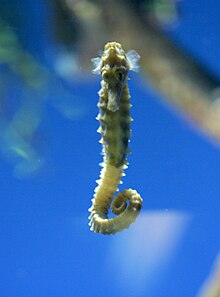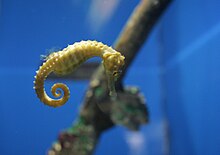Lined seahorse
| Lined seahorse | |
|---|---|
| File:Matt.jpg | |
| Scientific classification | |
| Kingdom: | |
| Phylum: | |
| Class: | |
| Order: | |
| Family: | |
| Genus: | |
| Species: | H. erectus
|
| Binomial name | |
| Hippocampus erectus Perry, 1810
| |
The lined seahorse (Hippocampus erectus), northern seahorse or spotted seahorse is a species of fish that belongs to the Syngnathidae family.[2]
Description

The lined seahorse is a diurnal species that ranges in length from 12 cm to 17 cm ; the maximum length reported for the species is 19 cm. The lined seahorse is sexually dimorphic, meaning there are distinct differences in appearances of males and females; most notably the brood pouch located on the male's abdomen which it utilized in reproduction. Males are also slightly larger in size and have longer prehensile tails than the females. In the wild, the lined seahorse has a lifespan of one to four years; however, in captivity their lifespan usually reaches the full four years. Four years is the maximum age reported for the species.[3] They have a broad color spectrum, ranging from black, grey, brown, and green, to orange, red, and yellow. However, their colors change due to altercations in their environment, diet, anxiety or stress level, and/or mood.[4] The lined seahorse is brawny and upright in appearance. They have an armor like body composed of approximately fifty bony plates. Together these bony plates form the outer skeleton of the species. It is common for the species to have white lines outlining the neck area and for tiny white dots to be present on the tail. The prehensile tail consists of numerous rings and the first, third, fifth, seventh, and eleventh may protrude farther outward than the remaining. The prehensile tail following the bony plates is utilized by the seahorse to grasp onto it's environment composed of seaweed and coral. The tail curls forward and is seldom aligned. When a lined seahorse is very young (two weeks to four weeks), the tail is extremely limber. The snout length is approximately half the head length of the lined seahorse. The cheek spines, located diagonally down from the eye on either side may be single or double. In total, the lined seahorse has eleven trunk rings, 34-39 tail rings, 16-20 dorsal fin rays, and 14-18 pectoral fin rays. The pectoral fin is level with the eye on each back side of the lined seahorse's head. The dorsal fin is located on the back of the skeleton and is level with the stomach-chest area. Females dorsal fins are slightly larger than males and is located lower on the back. The eyes of the lined seahorse can concentrate together, or they can operate independently of one another. [5] The lined seahorse may be considered sexually mature as early as four months; however, it is typically about eight months. The minimum size of a sexually mature lined seahorse is 5.6 cm. [4][6]
Habitat and distribution
The lined seahorse is found in the Atlantic Ocean, spotted as far north as Nova Scotia, Canada, and as far south as Venezuela in South America. They can be found on the east coast of America in Connecticut, Delaware, Florida, Georgia, Louisiana, Maryland, New Jersey, New York, and North Carolina, as well as in the waters surrounding Mexico and the Caribbean. Species found in Brazil seem to be of a different species, however, more research is needed to determine. The lined seahorse is native to the following locations: Nova Scotia, Canada, United States, Bermuda, Cuba, Mexico (Veracruz, Yucatán), Haiti, Saint Kitts and Nevis, Belize, Honduras, Nicaragua, Costa Rica, Panama, Guatemala, and Venezuela.
The species is common in depths of water up to seventy-three meters. The habitat of the lined seahorse consists of marine vegetation, such as suspended Sargassum, seagrass, sponges, and mangroves. Depending on the season, the species can be found in shallow waters or deep waters along beaches, oyster beds, and banks covered in vegetation, as well as in bays or salt marshes. [7] In the winter, the seahorses are more prominent in deeper waters, versus warmer months, where they can be found in shallow waters in the various types of aquatic vegetation mentioned above.[8]
The temperature in which the H. erectus dwells varies with the different latitudes and has an effect on gonad development, brood size, and juvenile development and survival. Many lined seahorses experience temperature fluctuations during tides daily cycles, the different seasons of each year, and due to precipitation or runoff. Adults do have the ability to migrate to deeper waters during cold seasons. A study showed that the highest survival and growth rate of juveniles occurred at 28 to 29 degrees Celsius in captivity. In addition to temperature, there is also a large range of salinity concentration depending on the location. The most common salinity is 25 to 35 ppt. In captivity, the species is most commonly kept at 35 ppt. [6]
Diet
The lined seahorse utilizes its elongated snout in order to consume its prey, consisting primarily of minute crustaceans, mollusks, and zoo plankton. Unfortunately, some captive parental males have been known to cannibalize small number of its own fry, or juveniles, following its release into natural habitat. In order to ambush its prey, the seahorse employs color changes to camouflage itself with its surrounding environment, locates the prey, and then jerks its head upward, forcing the prey in the right position to be sucked in through its tubular snout. The lined seahorse is highly accurate, especially if its prey is within one inch from its snout. Overall, this process is quick and accurate. A growing lined seahorse may feed continuously for up to ten hours a day, engulfing approximately 3,600 baby brine shrimp. [5][8] [6]
Predators and Parasites

Some of the H. erectus include crabs, rays, various type of sea turtles, skates, and sea birds. Although their camouflage tactics reduce their risk of becoming prey, their poor swimming and ability to swim increase their likelihood of being consumed by their predators, especially large fish. [9]
There are many parasites and infections known to affect the lined seahorse, including ciliates (Uronemamarinum), nematodes, fungi, myxosporidian, and microsporidians (Glugea heraldi). [6]
Behavior
A unique characteristic of the lined seahorse (and other species of seahorse) is their practice of monogamy: the male and female seahorses choose partners that they will continue to mate with for their lifetime.[10] The monogamous characteristics of the lined seahorse include ritual dances with their partner that they perform every morning. These dances establish their permanent relationship as mates. If a male or female lined seahorse should lose their partner for any reason, it takes time before they replace their mate.[5]

Lined seahorses are weak swimmers; hence why they use their snouts to suck in their prey since they are not speedy enough to hunt or chase. The lined seahorse propels its body forward with its dorsal and pectoral fins, which they move rapidly back and forth. These fins are also utilized in directing their bodies throughout the water.[5]
In addition to monogamy, the lined seahorse also cues into sound-making in the mating process. The seahorses have a crown-like bony crest called a coronet located on the backside of their head at the edge of the skull. The coronet resembles a star pattern and is attached rather loosely and has sharp edges. [6] As the seahorse lifts its head, the edge of the skull slides beneath the coronet and out when the seahorse bows its head. As the skull's edge slides beneath and out from the coronet, a clicking sound is produced. Mating seahorses swim slowly together, alternating their clicking sounds, until they embrace one another. Once the male and female seahorse embrace, the sounds from both the male and female unify, becoming indistinguishable from one another. This action creates a louder, consecutive sound, further establishing their bond.[5]
Reproduction

Like all species of seahorses, the lined seahorse reproduces sexually, laying eggs every season. In addition, the male is the parent that looks after the newborn seahorses. The reproduction process begins at the initiation of the courtship process. Courtship extends for a couple of days and during this process, both the male and female may change to a pale color. The male enlarges his pouch to indicate his desire to pursue the female. Once they are established as monogamous mates though dances and clicking sounds, intercourse takes place. During intercourse, the female sprays her eggs into the males pouch, which is called a "brood pouch," where they are fertilized and sealed. Females can carry over one thousand eggs and the males' brood size can range from 97 to 1,552 eggs. The number of eggs the female produces varies depending on the size of the seahorse. The eggs are 1.5 mm in diameter. When the eggs are being incubated within the male's pouch, the embryos are provided oxygen via an extensive capillary system. Through this system, the sodium and calcium levels can be altered in order to maintain homeostasis within the pouch environment. When the embryos are approaching birth, the pouch environment is very similar to the seawater. The gestation period lasts for 20-21 days. When the time finally approaches, the male latches his prehensile tail onto a supportive object while he braces back and forth, until the developed seahorses escape from the pouch. The bracing continues until all seahorses have successfully escaped the pouch. However, unhatched seahorses that have died will create a gas within the male's pouch. Soon after, the male seahorse inevitably floats to the surface, only to become easy prey in the marine food chain. Juveniles are approximately 11 mm at birth for three days and are considered embryos until they are capable of swimming on their own. Juveniles do not reach maximum size until they are 8–10 months of age. In captivity, the species maintained a vertical growth rate of 0.55 mm a day for 100 days. Male juveniles develop pouches when they are 5 to 7 months old. The juvenile seahorses quickly develop the characteristic of the adult lined seahorse. After birth, courtship begins once again. Breeding occurs in the months of May through October in the Chesapeake Bay. July is when the lined seahorse population is the greatest in Florida. [8] [5] [6]
Aquarium life
The minimum habitat requirements for captive lined seahorses consist of a tank 18 inches vertical in height and 20 to 25 gallons for a pair, 30 to 40 gallons for two pairs. The tank should be kept at a constant temperature between 22 and 25 degrees Celsius (72 and 77 degrees Fahrenheit).[4]
References
- ^ "Hippocampus erectus". International Union for Conservation of Nature and Natural Resources. 2011. Retrieved 2011-12-08.
- ^ Froese, R.; Pauly, D. "Hippocampus erectus Perry, 1810 Lined Seahorse". FishBase.
- ^ Rosamond Gifford Zoo Volunteers (July 23, 2005). "Lined Seahorse" (PDF).
- ^ a b c "H. erectus". Seahorse Source, Inc. 2005. Retrieved 31 October 2011.
- ^ a b c d e f Gardiner, Nick, University of Michigan. "Hippocampus erectus". Animal Diversity Web. Retrieved 31 October 2011.
{{cite web}}: CS1 maint: multiple names: authors list (link) - ^ a b c d e f Sweat, L.H. [www.sms.si.edu/IRLSpec/Hippoc_erectu.htm "Hippocampus erectus"]. Smithsonian Marine Station at Fort Pierce 2009.
{{cite web}}: Check|url=value (help) - ^ "Hippocampus erectus". IUCN Red List of Threatened Species Version 2011 Project Seahorse 2003.
- ^ a b c "Lined Seahorse". Chesapeake Bay Program (Bay Field Guide).
- ^ Bayville. "Lined Seahorse" (PDF). 2005 Maryland Public Television.
- ^ Project Seahorse Team". "Introduction to seahorses". Project Seahorse.


